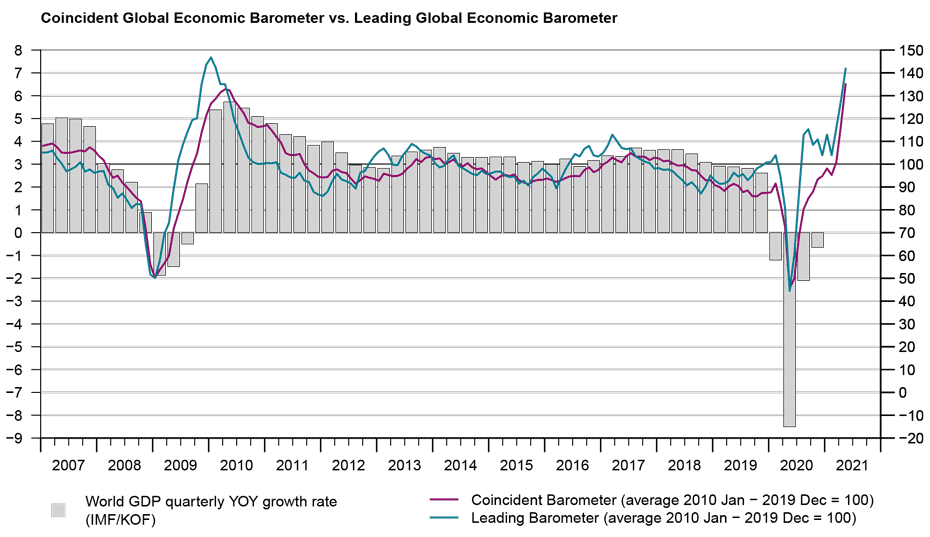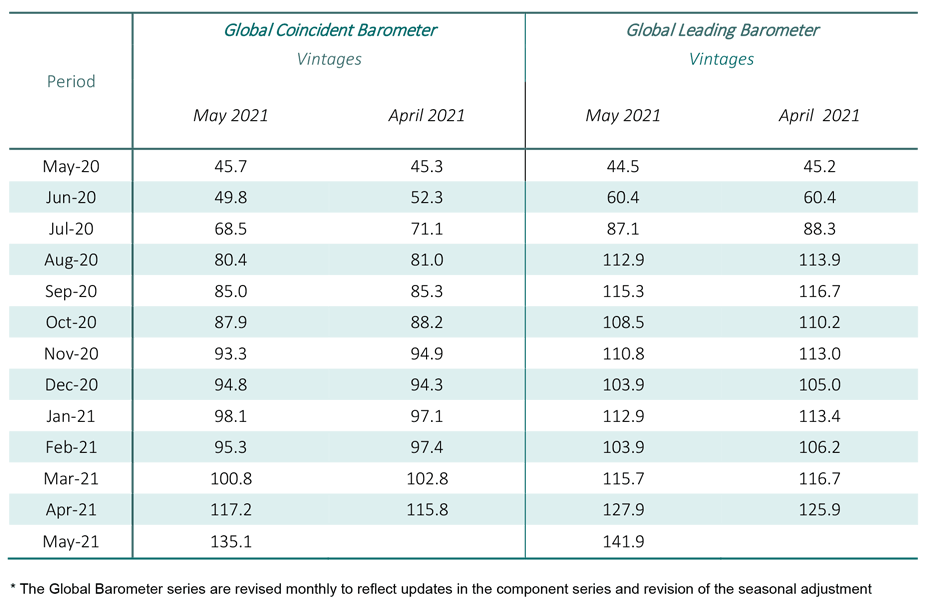Global Barometers signal that the recovery has spread to all regions and sectors
The Global Economic Barometers increase considerably in May for the third month in a row, signaling an acceleration in the global economic activity since the first quarter of 2021. All investigated regions improve both their assessment of the current situation and expectations for the near future.
The Coincident Global Barometer rises by 17.9 points in May, from 117.2 points to 135.1 points, the highest level of the historical series since 1991. The Leading Global Barometer climbs 14.0 points, to 141.9 points, its highest level since February 2010. All regions developed positively and markedly this month, both regarding the assessment of the present situation and the expectations for the near future.
“As worldwide survey results feeding into the various barometers for the global economy show, the outlook continues to brighten and finds an increasingly broad base. While the pandemic is still omnipresent, the vaccination campaigns combined with large stimulus packages are already making themselves felt across much of the economy. The likelihood of setbacks in containing the virus and the associated risks to the world economy appear to be assessed as low”, evaluates Jan-Egbert Sturm, Director of KOF Swiss Economic Institute.

Coincident Barometer – regions and sectors
All the regions contribute positively to the aggregate result of the Coincident Barometer in May. Europe, with 6.5 points, is the region contributing the strongest to the rise in the Coincident Global Barometer followed by the Western Hemisphere with 6.1 points, and the Asia, Pacific and Africa region with 5.3 points. For the second consecutive month, the assessment of the present situation is noticeably more positive in all the regions, influenced by the acceleration in the level of activity. In most of the countries the situation today has much improved compared to the one observed 12 months ago at the peak of the COVID-crisis. The graph below illustrates the contribution of each region to the deviation of the Coincident Barometer from the historical average of 100 points.
All five identified sectors contribute positively to the aggregate result of the Coincident Barometer. The increase of 31.1 points in the coincident indicator for the Services sector stands out, as this is the sector that has suffered most due to the measures taken to contain the virus circulation in various countries. All the indicators are above the level of 117 points, with the Services and Industry sectors, and the indicator that measures the aggregated development of economies (Overall Economic Development) reaching the highest level of the series since 1991, the first observation of the Barometers.
Leading Barometer – regions and sectors
The Leading Global Barometer leads the world economic growth rate cycle by three to six months on average. In May, as the Coincident Barometer, the leading indicators of the three regions each contribute positively to the 14-points rise in the Leading Global Barometer. This month, the Western Hemisphere is the biggest contributor to the rise, adding 7.9 points, followed by the Asia, Pacific and Africa region with 3.8 points and Europe with 2.3 points.
All the Leading Barometer sectors increase in May, influenced by the ongoing vaccination campaigns around the world and the improved prospects for the economy to return to a situation of normality. All sectors record levels above 130 points, reflecting a highly optimistic outlook regarding the near future. With the possibility of a reduction in virus containment measures, the Services sector has become the most optimistic, with an indicator of 150 points, the highest since the start of the series in 1991.
In May, all sectors contribute positively to the aggregate result of the Leading Barometer. The strongest increase of 16.3 points is that of the leading indicator for Industry, followed by that of Services with a rise of 13.8 points.

The full press release with tables and graphs can be found Download here (PDF, 540 KB).
More information on the Global Economic Barometers can be found here.
The Global Economic Barometers
The Global Economic Barometers are a system of indicators enabling timely analysis of global economic development. They represent a collaboration between the KOF Swiss Economic Institute of the ETH Zurich in Switzerland and Fundação Getulio Vargas (FGV), based in Rio de Janeiro, Brazil. The system consists of two composite indicators, the Coincident Barometer and the Leading Barometer. The Coincident Barometer reflects the current state of economic activity, while the Leading Barometer provides a cyclical signal roughly six months ahead of current economic developments.
The two Barometers comprise the results of economic tendency surveys conducted in more than 50 countries with the aim of achieving the broadest possible global coverage. The advantages of economic tendency surveys are that their results are usually readily available and are not substantially revised after first publication.
The Coincident Barometer includes more than 1,000 different time series, while the Leading Barometer consists of over 600 time series. Cross-correlation analysis is used to decide which individual time series are included in the barometers. This involves correlating the individual time series with a reference series. The reference series used is the year-on-year growth rate of global gross domestic product (GDP), where the individual national GDPs are aggregated at purchasing power parity to form global GDP. A time series is only included in a Barometer if it shows a sufficiently high correlation and a suitable synchronization or lead with the reference series. The time period used for this correlation analysis currently runs from January 2010 to December 2019.
The series of the two Barometers are revised each month at publication and are standardized to have a mean of 100 and a standard deviation of 10 for the 10-year period previous to the most recent observations.
The methodology is described in:
Klaus Abberger, Michael Graff, Aloisio Jr. Campelo, Anna Carolina Lemos Gouveia, Oliver Müller and Jan-Egbert Sturm (2020), The Global Economic Barometers: Composite indicators for the world economy. KOF Working Papers, vol. 471, Zurich: KOF Swiss Economic Institute, ETH Zurich, 2020.